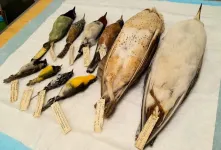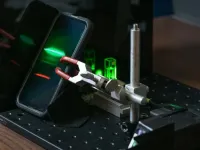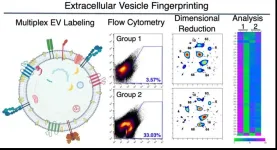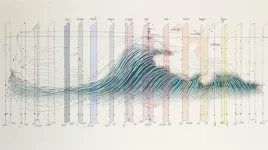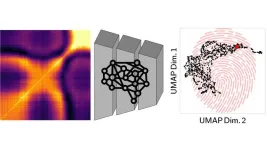(Press-News.org) A biology researcher at The University of Texas at Arlington has received a prestigious grant to continue and expand his research on how pollution affects wildlife.
Jordan Brown, a postdoctoral research associate in biology, was awarded a Postdoctoral Research Fellowship from the National Science Foundation’s (NSF) Directorate for Biological Sciences. The award supports researchers whose work focuses on how environmental changes affect animals.
Dr. Brown works in the lab of Shane DuBay, UTA assistant professor of biology, who studies evolutionary ecology, environmental science, and natural history to better understand the consequences of environmental change on the world.
“I was always very confident that I would somehow be able to complete all my research plans for the next few years, especially with Dr. DuBay’s help, but having NSF support is going to remove so many barriers and provide so many new opportunities to expand my research,” said Brown.
“It’s really exciting to see the NSF support the innovative research that Jordan has been developing—it’s a huge accomplishment,” DuBay said. “His work has incredible potential to advance our knowledge about pollution histories and the diverse and uneven impacts of environmental pollution.”
One of Brown’s projects involves analyzing bird specimens from museum collections in Europe to assess whether they can be used as indicators of air pollution between the mid-1800s and the present day. Many older bird samples were collected in industrialized areas and are notably darker in their plumage than those from areas without as much industrialization. This is due to the presence of black carbon particles emitted by factories during the 19th and early 20th centuries.
This research builds and expands on previous work done by DuBay that looked at bird specimens from U.S. museums to help reconstruct historical levels of soot pollution and, ultimately, provide a better understanding of the role black carbon plays in climate change. Brown will use image analysis software on photographs of bird samples from European museums to determine whether the level of air pollution from the time and place the specimens were collected can be measured.
Brown developed a fascination with nature early in his life. “I realized that nature is not just interesting, it’s also important. I found myself wanting to know more about biological and ecological systems,” he said. His dissertation focused on detecting and characterizing the microbes that live inside concrete, with the goal of demonstrating that unexpected ecosystems can develop in places that are made specifically by and for humans.
Brown joined DuBay’s lab in fall 2023 to continue researching urban ecology and industrial pollution.
“I am excited to finally have a chance to focus on pollution,” he said. “Every instance of pollution has a story behind it as well as unknown consequences for the future. We’re going to figure out how basic ecology and industrial activities have interacted to produce some of the pollution problems we’re dealing with now.”
END
UTA biologist wins national fellowship to study historic pollution
Researcher analyzing museum specimens to track how air pollution affected wildlife
2024-07-16
ELSE PRESS RELEASES FROM THIS DATE:
Even on Instagram, teens mostly feel bored
2024-07-16
Concern that social media is driving the teen mental health crisis has risen to such a pitch that the majority of states in the country have filed lawsuits against Meta (which owns Instagram and Facebook) and the U.S. surgeon general called last month for warning labels on platforms, similar to those on tobacco.
New research from the University of Washington finds, though, that while some teens do experience negative feelings when using Instagram, the dominant feeling they have around the platform is boredom. They open the app because they’re bored. Then they sift through largely irrelevant content, mostly feeling bored, while seeking interesting bits to ...
UC Irvine’s electronic patient-reported outcome tool reduces cancer care disparities
2024-07-16
Irvine, Calif., July 15, 2024 — A University of California, Irvine research team has developed and implemented an intervention to enhance cancer care support services for racial and ethnic minority patients undergoing chemotherapy.
The electronic patient-reported outcome tool is a web-based application that allows individuals to enter their health data into a smartphone, tablet or computer. In this study, the ePRO was available in multiple languages and coupled with digital analytics. At each treatment visit, participants digitally ...
Research shows protein isoform inhibitors may hold the key to making opioids safer
2024-07-16
Researchers at the University of Arizona Health Sciences identified a new way to make opioids safer, increasing the pain-relieving properties of opioids while decreasing unwanted side effects through the spinal inhibition of a Heat shock protein 90 isoform.
Opioids are the gold standard of chronic pain treatment, but they come with a host of negative side effects including constipation, addiction potential and respiratory depression that can lead to death. This study, published in Scientific Reports, offers a potential new way to treat acute and chronic pain by reducing the amount of opioid needed for ...
Pocket-sized invention revolutionizes ability to detect harmful materials
2024-07-16
Imagine knowing what berry or mushroom is safe to eat during a hike or swiftly detecting pathogens in a hospital setting that would traditionally require days to identify.
Identification and detection of drugs, chemicals and biological molecules invisible to the human eye can be made possible through the combined technology of a cellphone camera and a Raman spectrometer — a powerful laser chemical analysis method.
Dr. Peter Rentzepis, a professor in the Department of Electrical and Computer Engineering at Texas A&M ...
A new addition to the CRISPR toolbox: Teaching the gene scissors to detect RNA
2024-07-16
Bacteria have developed special defense mechanisms to protect themselves against viruses, which by no means infect only humans. As part of these so-called CRISPR-Cas systems, a CRISPR ribonucleic acid (crRNA), which serves as a “guide RNA,” recognizes regions of a foreign genome, such as viral DNA. The CRISPR-associated (Cas) nuclease, directed by a crRNA, then renders it harmless by cutting it like a pair of scissors. Humans have exploited this strategy: “CRISPR, often referred to as ‘gene scissors’, is the basis of many molecular technologies,” says ...
Vanderbilt scientists develop new tool that could lead to noninvasive “liquid biopsies”
2024-07-16
Biopsies are clinical tools commonly used to diagnose a variety of diseases or to monitor tissue for abnormal growth or even rejection of a transplant. During biopsies, tissue samples are removed from the body so they can be examined more closely, but depending on the type of tissue that’s needed, the procedure can be rather invasive.
Researchers from the School of Medicine Basic Sciences recently developed an analytical tool that could lead to the use of “liquid biopsies” as a substitute ...
Many breast cancer survivors do not receive genetic testing, despite being eligible
2024-07-16
ANN ARBOR, Michigan — As cancer treatment and survivorship care relies more on understanding the genetic make-up of an individual’s tumor, a new study from the University of Michigan Health Rogel Cancer Center finds that many breast cancer survivors who meet criteria for genetic counseling and testing are not receiving it.
The good news: Among those who do get testing, nearly two-thirds who have a genetic variant are reaching out to family members to talk about their results.
“Our findings support a rapidly growing movement to simplify clinical guidelines to ...
Scientists find that small regions of the brain can take micro-naps while the rest of the brain is awake and vice versa
2024-07-16
Sleep and wake: they’re totally distinct states of being that define the boundaries of our daily lives. For years, scientists have measured the difference between these instinctual brain processes by observing brain waves, with sleep characteristically defined by slow, long-lasting waves measured in tenths of seconds that travel across the whole organ.
For the first time, scientists have found that sleep can be detected by patterns of neuronal activity just milliseconds long, 1000 times shorter than a second, revealing a new way to study and understand the basic brain ...
Scientists develop new artificial intelligence method to create material ‘fingerprints’
2024-07-16
Study shows how materials change as they are stressed and relaxed.
Like people, materials evolve over time. They also behave differently when they are stressed and relaxed. Scientists looking to measure the dynamics of how materials change have developed a new technique that leverages X-ray photon correlation spectroscopy (XPCS), artificial intelligence (AI) and machine learning.
This technique creates “fingerprints” of different materials that can be read and analyzed by ...
Sun-like stars found orbiting hidden companions
2024-07-16
Most stars in our universe come in pairs. While our own Sun is a loner, many stars like our Sun orbit similar stars, while a host of other exotic pairings between stars and cosmic orbs pepper the universe. Black holes, for example, are often found orbiting each other. One pairing that has proved to be quite rare is that between a Sun-like star and a type of dead star called a neutron star.
Now, astronomers led by Caltech's Kareem El-Badry have uncovered what appear to be 21 neutron stars in orbit around stars like our Sun. Neutron stars are dense burned-out ...
LAST 30 PRESS RELEASES:
Making lighter work of calculating fluid and heat flow
Normalizing blood sugar can halve heart attack risk
Lowering blood sugar cuts heart attack risk in people with prediabetes
Study links genetic variants to risk of blinding eye disease in premature infants
Non-opioid ‘pain sponge’ therapy halts cartilage degeneration and relieves chronic pain
AI can pick up cultural values by mimicking how kids learn
China’s ecological redlines offer fast track to 30 x 30 global conservation goal
Invisible indoor threats: emerging household contaminants and their growing risks to human health
Adding antibody treatment to chemo boosts outcomes for children with rare cancer
Germline pathogenic variants among women without a history of breast cancer
Tanning beds triple melanoma risk, potentially causing broad DNA damage
Unique bond identified as key to viral infection speed
Indoor tanning makes youthful skin much older on a genetic level
Mouse model sheds new light on the causes and potential solutions to human GI problems linked to muscular dystrophy
The Journal of Nuclear Medicine ahead-of-print tip sheet: December 12, 2025
Smarter tools for peering into the microscopic world
Applications open for funding to conduct research in the Kinsey Institute archives
Global measure underestimates the severity of food insecurity
Child survivors of critical illness are missing out on timely follow up care
Risk-based vs annual breast cancer screening / the WISDOM randomized clinical trial
University of Toronto launches Electric Vehicle Innovation Ontario to accelerate advanced EV technologies and build Canada’s innovation advantage
Early relapse predicts poor outcomes in aggressive blood cancer
American College of Lifestyle Medicine applauds two CMS models aligned with lifestyle medicine practice and reimbursement
Clinical trial finds cannabis use not a barrier to quitting nicotine vaping
Supplemental nutrition assistance program policies and food insecurity
Switching immune cells to “night mode” could limit damage after a heart attack, study suggests
URI-based Global RIghts Project report spotlights continued troubling trends in worldwide inhumane treatment
Neutrophils are less aggressive at night, explaining why nighttime heart attacks cause less damage than daytime events
Menopausal hormone therapy may not pose breast cancer risk for women with BRCA mutations
Mobile health tool may improve quality of life for adolescent and young adult breast cancer survivors
[Press-News.org] UTA biologist wins national fellowship to study historic pollutionResearcher analyzing museum specimens to track how air pollution affected wildlife
